
The politics of Finland take place within the framework of a parliamentary representative democracy. Finland is a republic whose head of state is President Sauli Niinistö, who leads the nation's foreign policy and is the supreme commander of the Finnish Defence Forces. Finland's head of government is Prime Minister Petteri Orpo, who leads the nation's executive branch, called the Finnish Government. Legislative power is vested in the Parliament of Finland, and the Government has limited rights to amend or extend legislation. The Constitution of Finland vests power to both the President and Government: the President has veto power over parliamentary decisions, although this power can be overruled by a majority vote in the Parliament.

Urho Kaleva Kekkonen, often referred to by his initials UKK, was a Finnish politician who served as the eighth and longest-serving president of Finland from 1956 to 1982. He also served as prime minister, and held various other cabinet positions. He was the third and most recent president from the Agrarian League/Centre Party. Head of state for nearly 26 years, he dominated Finnish politics for 31 years overall. Holding a large amount of power, he won his later elections with little opposition and has often been classified as an autocrat. Nevertheless, he remains a respected figure.
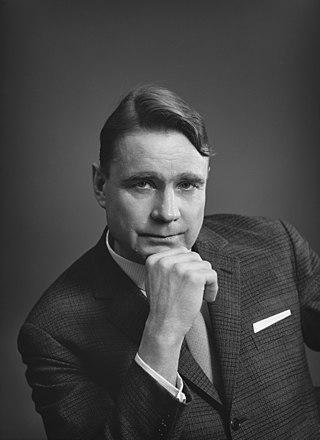
Mauno Henrik Koivisto was a Finnish politician who served as the ninth president of Finland from 1982 to 1994. He also served as the country's prime minister twice, from 1968 to 1970 and again from 1979 to 1982. He was also the first member of the Social Democratic Party to be elected as President of Finland.
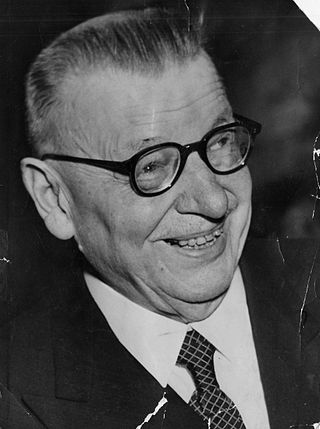
Juho Kusti Paasikivi was a Finnish politician who served as the seventh president of Finland from 1946 to 1956. Representing the Finnish Party until its dissolution in 1918 and then the National Coalition Party, he previously served as senator, member of parliament, envoy to Stockholm (1936–1939) and Moscow (1940–1941), and Prime Minister of Finland. He also held several other positions of trust, and was an influential figure in Finnish economics and politics for over fifty years.
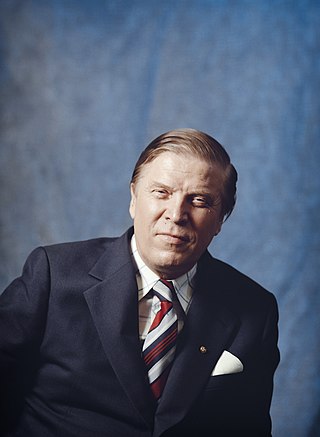
Johannes Virolainen was a Finnish politician and who served as 30th Prime Minister of Finland, helped inhabitants of Karelia and created Mandatory Swedish in Finnish basic schools.
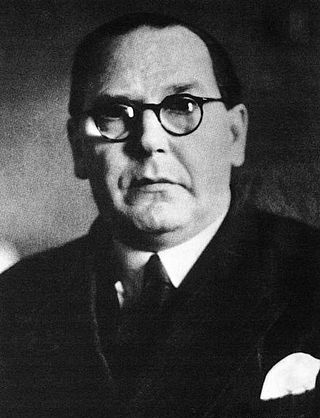
Karl-August Fagerholm was a Finnish politician. Fagerholm served as Speaker of Parliament and three times Prime Minister of Finland. Fagerholm became one of the leading politicians of the Social Democrats after the armistice in the Continuation War. As a Scandinavia-oriented Swedish-speaking Finn, he was believed to be more to the taste of the Soviet Union's leadership than his predecessor, Väinö Tanner. Fagerholm's postwar career was, however, marked by fierce opposition from both the Soviet Union and the Communist Party of Finland. He narrowly lost the presidential election to Urho Kekkonen in 1956.

Keijo Antero Liinamaa was a Finnish lawyer and politician who served as caretaker Prime Minister of Finland from June to November 1975.

Ahti Kalle Samuli Karjalainen was a Finnish economist and politician. He was a member of the Agrarian League and served two terms as Prime Minister of Finland. He is, however, better known for his period as Minister of Foreign Affairs of Finland. Karjalainen is considered one of the most influential figures in post-war Finnish politics. Like President Urho Kekkonen, Karjalainen attached great importance to Finland's relationship with the Soviet Union, and was at one point considered to be Kekkonen's likely successor until alcoholism affected his later career.

Kustaa Rafael Paasio, born Hellström was a prominent Finnish politician and editor from Social Democratic Party. He served as Prime Minister of Finland twice.

Sakari Severi Tuomioja was a Finnish politician and diplomat who served as Prime Minister of Finland between 1953–1954 and as Minister for Foreign Affairs between 1951–1952 and as the Governor of the Bank of Finland between 1945–1955. He was also Finland's ambassador in London and Stockholm.
Parliamentary elections were held in Finland on 1 and 2 July 1951.
Parliamentary elections were held in Finland on 7 and 8 March 1954.
Parliamentary elections were held in Finland on 21 and 22 September 1975.
The Note Crisis was a political crisis in Soviet–Finnish relations in 1961. The Soviet Union sent Finland a diplomatic note on October 30, 1961, referring to the threat of war and West German militarization and proposing that Finland and the Soviet Union begin consultations on securing the defence of both countries, as provided for in the Finno-Soviet Treaty of 1948. The note coincided with the detonation of the Tsar Bomba, the most powerful nuclear test in history, and followed close on the heels of the Berlin Crisis and Bay of Pigs Invasion.

Kekkonen's second cabinet was the 34th government of Finland, which existed from 17 January 1951 to 20 September 1951. It was a majority government, and its Prime Minister was Urho Kekkonen.
Kekkonen's third cabinet was the 35th government of Finland. The majority government lasted from 20 September 1951 to 9 August 1953. The cabinet’s Prime Minister was Urho Kekkonen.

Karl-August Fagerholm's third cabinet, also known as the Night Frost Cabinet or the Night Frost Government, was the 44th government of Republic of Finland, in office from August 9, 1958 to January 13, 1959. It was a majority government. The cabinet was formed after the parliamentary election of 1958.
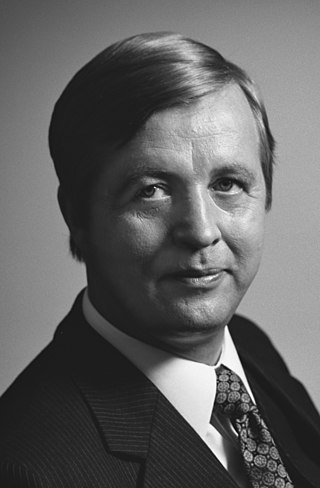
The first cabinet of Kalevi Sorsa was the 56th government of Finland. The cabinet's Prime Minister was Kalevi Sorsa. The cabinet was in office from 4 September 1972 to 13 June 1975.
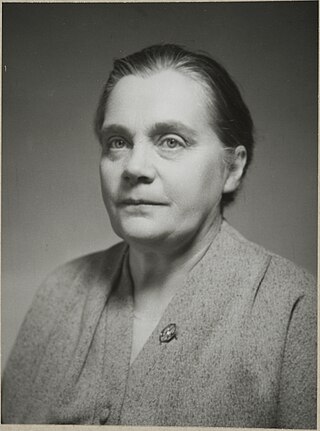
Vieno Simonen was a Finnish politician and farmer. A member of the Agrarian League, she represented Kuopio East in the Parliament of Finland from 1948 to 1962. After serving in deputy ministerial positions in the Kekkonen IV, Törngren, and Fagerholm II cabinets, she was twice appointed as minister of social affairs by prime ministers V. J. Sukselainen and Martti Miettunen, and held the position from 1959 to 1962.

Kerttu Saalasti was a Finnish politician who was the Finland Minister of Education from 1954 to 1956 and from May 1957 to November 1957. She was the first female Minister of Education in Finland, and introduced the legislation that established the University of Oulu. A member of the Agrarian League, Saalasti also represented Oulu in the Parliament of Finland from 1948 to 1962 and from 1966 to 1970.































